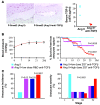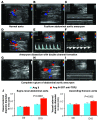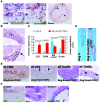TGF-beta activity protects against inflammatory aortic aneurysm progression and complications in angiotensin II-infused mice
- PMID: 20101093
- PMCID: PMC2810071
- DOI: 10.1172/JCI38136
TGF-beta activity protects against inflammatory aortic aneurysm progression and complications in angiotensin II-infused mice
Abstract
Complicated abdominal aortic aneurysm (AAA) is a major cause of mortality in elderly men. Ang II-dependent TGF-beta activity promotes aortic aneurysm progression in experimental Marfan syndrome. However, the role of TGF-beta in experimental models of AAA has not been comprehensively assessed. Here, we show that systemic neutralization of TGF-beta activity breaks the resistance of normocholesterolemic C57BL/6 mice to Ang II-induced AAA formation and markedly increases their susceptibility to the disease. These aneurysms displayed a large spectrum of complications on echography, including fissuration, double channel formation, and rupture, leading to death from aneurysm complications. The disease was refractory to inhibition of IFN-gamma, IL-4, IL-6, or TNF-alpha signaling. Genetic deletion of T and B cells or inhibition of the CX3CR1 pathway resulted in partial protection. Interestingly, neutralization of TGF-beta activity enhanced monocyte invasiveness, and monocyte depletion markedly inhibited aneurysm progression and complications. Finally, TGF-beta neutralization increased MMP-12 activity, and MMP-12 deficiency prevented aneurysm rupture. These results clearly identify a critical role for TGF-beta in the taming of the innate immune response and the preservation of vessel integrity in C57BL/6 mice, which contrasts with its reported pathogenic role in Marfan syndrome.
Figures







Comment in
-
TGF-beta in the pathogenesis and prevention of disease: a matter of aneurysmic proportions.J Clin Invest. 2010 Feb;120(2):403-7. doi: 10.1172/JCI42014. Epub 2010 Jan 25. J Clin Invest. 2010. PMID: 20101091 Free PMC article.
Similar articles
-
TGF-β (Transforming Growth Factor-β) Signaling Protects the Thoracic and Abdominal Aorta From Angiotensin II-Induced Pathology by Distinct Mechanisms.Arterioscler Thromb Vasc Biol. 2017 Nov;37(11):2102-2113. doi: 10.1161/ATVBAHA.117.309401. Epub 2017 Jul 20. Arterioscler Thromb Vasc Biol. 2017. PMID: 28729364 Free PMC article.
-
Deficiency of Endogenous Acute-Phase Serum Amyloid A Protects apoE-/- Mice From Angiotensin II-Induced Abdominal Aortic Aneurysm Formation.Arterioscler Thromb Vasc Biol. 2015 May;35(5):1156-65. doi: 10.1161/ATVBAHA.114.304776. Epub 2015 Mar 5. Arterioscler Thromb Vasc Biol. 2015. PMID: 25745063 Free PMC article.
-
[Naringenin inhibits thoracic aortic aneurysm formation in mice with Marfan syndrome].Beijing Da Xue Xue Bao Yi Xue Ban. 2022 Oct 18;54(5):896-906. doi: 10.19723/j.issn.1671-167X.2022.05.017. Beijing Da Xue Xue Bao Yi Xue Ban. 2022. PMID: 36241232 Free PMC article. Chinese.
-
Pathogenic and Therapeutic Significance of Angiotensin II Type I Receptor in Abdominal Aortic Aneurysms.Curr Drug Targets. 2018;19(11):1318-1326. doi: 10.2174/1389450119666180122155642. Curr Drug Targets. 2018. PMID: 29359665 Review.
-
Conundrum of angiotensin II and TGF-β interactions in aortic aneurysms.Curr Opin Pharmacol. 2013 Apr;13(2):180-5. doi: 10.1016/j.coph.2013.01.002. Epub 2013 Mar 12. Curr Opin Pharmacol. 2013. PMID: 23395156 Free PMC article. Review.
Cited by
-
Locally applied leptin induces regional aortic wall degeneration preceding aneurysm formation in apolipoprotein E-deficient mice.Arterioscler Thromb Vasc Biol. 2013 Feb;33(2):311-20. doi: 10.1161/ATVBAHA.112.300543. Epub 2012 Dec 6. Arterioscler Thromb Vasc Biol. 2013. PMID: 23220275 Free PMC article.
-
SMAD3 deficiency promotes inflammatory aortic aneurysms in angiotensin II-infused mice via activation of iNOS.J Am Heart Assoc. 2013 Jun 19;2(3):e000269. doi: 10.1161/JAHA.113.000269. J Am Heart Assoc. 2013. PMID: 23782924 Free PMC article.
-
TGF-β Neutralization Enhances AngII-Induced Aortic Rupture and Aneurysm in Both Thoracic and Abdominal Regions.PLoS One. 2016 Apr 22;11(4):e0153811. doi: 10.1371/journal.pone.0153811. eCollection 2016. PLoS One. 2016. PMID: 27104863 Free PMC article.
-
The mechanism and therapy of aortic aneurysms.Signal Transduct Target Ther. 2023 Feb 3;8(1):55. doi: 10.1038/s41392-023-01325-7. Signal Transduct Target Ther. 2023. PMID: 36737432 Free PMC article. Review.
-
Molecular and Cellular Mechanisms Involved in Aortic Wall Aneurysm Development.Diagnostics (Basel). 2023 Jan 10;13(2):253. doi: 10.3390/diagnostics13020253. Diagnostics (Basel). 2023. PMID: 36673063 Free PMC article. Review.
References
-
- Best VA, Price JF, Fowkes FG. Persistent increase in the incidence of abdominal aortic aneurysm in Scotland, 1981-2000. Br J Surg. 2003;90(12):1510–1515. - PubMed
-
- Fleming C, Whitlock EP, Beil TL, Lederle FA. Screening for abdominal aortic aneurysm: a best-evidence systematic review for the U.S. Preventive Services Task Force. Ann Intern Med. 2005;142(3):203–211. - PubMed
Publication types
MeSH terms
Substances
LinkOut - more resources
Full Text Sources
Other Literature Sources
Molecular Biology Databases
Miscellaneous

